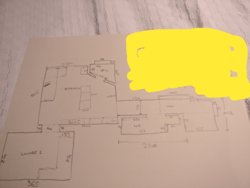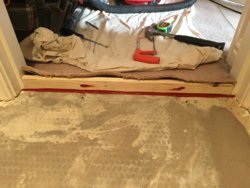Hi all,
Having been doing a lot of reading but have come for some advice if at all possible, please.
We had a major flood on the downstairs of our home and to cut a long story short, under the tiles weren’t drying so they had to come up. The tiles that were taken up were Eagle Dark Grey Polished Porcelain from CTD, circa £50 sqm and the floor area is 37 sqm (hallway, downstairs WC, kitchen/diner, rear lounge and small utility, see my attached [terrible] illustration of layout).
The missus hated how cold the tiles were (concrete floor) so we’re looking at adding in some electric underfloor heating (ufh) during the installation of the new tiling. I think we’re looking at 21-22sqm for the heat mat.
As I understand, the process would be something like this:
Thanks in advance and also thanks for all the amazing info I have read through so far on this forum!

Having been doing a lot of reading but have come for some advice if at all possible, please.
We had a major flood on the downstairs of our home and to cut a long story short, under the tiles weren’t drying so they had to come up. The tiles that were taken up were Eagle Dark Grey Polished Porcelain from CTD, circa £50 sqm and the floor area is 37 sqm (hallway, downstairs WC, kitchen/diner, rear lounge and small utility, see my attached [terrible] illustration of layout).
The missus hated how cold the tiles were (concrete floor) so we’re looking at adding in some electric underfloor heating (ufh) during the installation of the new tiling. I think we’re looking at 21-22sqm for the heat mat.
As I understand, the process would be something like this:
- Subfloor is concrete (house built 2010), old tiles came up very cleanly so doesn’t need SLC
- 10mm insulation board stuck to concrete with flexible adhesive
- WarmFloor Elektra heat mat (from Uheat) on top of insulation boards
- Tiles directly on top of insulation/ufh using flexible adhesive (the one tiler I’ve spoken with said this was his preference)
- Woodwork such as skirting/architrave all to be replaced once tiling finished (i.e. there will be no skirting on during tiling)
- Does the concrete need to be primed for the insulation board to adhere (fibreglass mesh and polymer mortar on each side of the board)? 10mm x 600mm x 1200mm £6.60 +VAT – the boards I was looking to get, do these look ok? They’re local to me. Better to get 1200 x 2400 if possible?
- Does the insulation board need to be primed?
- Is there a benefit to taping the joints in the insulation board? Looks inexpensive just it’s not come up in discussions but I had seen it in use on this forum
- If the heated area is 21-22sqm, is there a best combination of mats to go for or just whichever works out cheapest? (looking at 200W mats from Uheat, max is 18sqm)
- Do we need to go as high as 200W? I just picked the highest thinking we could turn it down if required, but there will be higher running costs involved I assume? Maybe the 160W would be sufficient and cheaper outlay/running costs? Uheat do a 22sqm matt for 160W but max for 200W seems 18sqm. Radiators in all the areas, some of which are being upgraded.
- Is there a recommendation to add zones/separate thermostats given the area stretching over different rooms? Similarly, is it advised to put the thermostat/probe in the room likely to be the coldest if only going with one?
- The big thing seems to be whether to SLC over the mat or not, with most recommending to do so on this forum as far as I can tell. The one tiler I’ve spoken with said he never does that and has done many a floor with electric underfloor heating without issues (not questioning him, just trying to think of things that could go wrong by NOT doing SLC over mat i.e air pockets/burn out, catching cable with trowel, easier to replace tiles in future without damaging heat mat etc)
- If chosen tiler was to SLC over the heat mat, is it then necessary to insulate under kitchen units and SLC under as well?
- There wasn’t any in the old floor, but do we need to consider expansion trim (not sure what it’s called) or is it sufficient to leave a small gap at the walls which will be hidden by the new skirting? (walls don’t go down to floor anyway)
- Are there any particular types of tiles to avoid? Sure I read a few comments about not using BCT and ufh but couldn’t remember why. More than likely to be a ceramic or porcelain tile going back down but probably looking at around £15-25sqm cost wise to make the ufh doable on the budget we have. Probably going with a 300x600 or 600x600 tile.
- For the electric supply for the thermostat/mat, can this be taken from a socket spur or because of the area does it need to go back to the consumer unit?
Thanks in advance and also thanks for all the amazing info I have read through so far on this forum!



